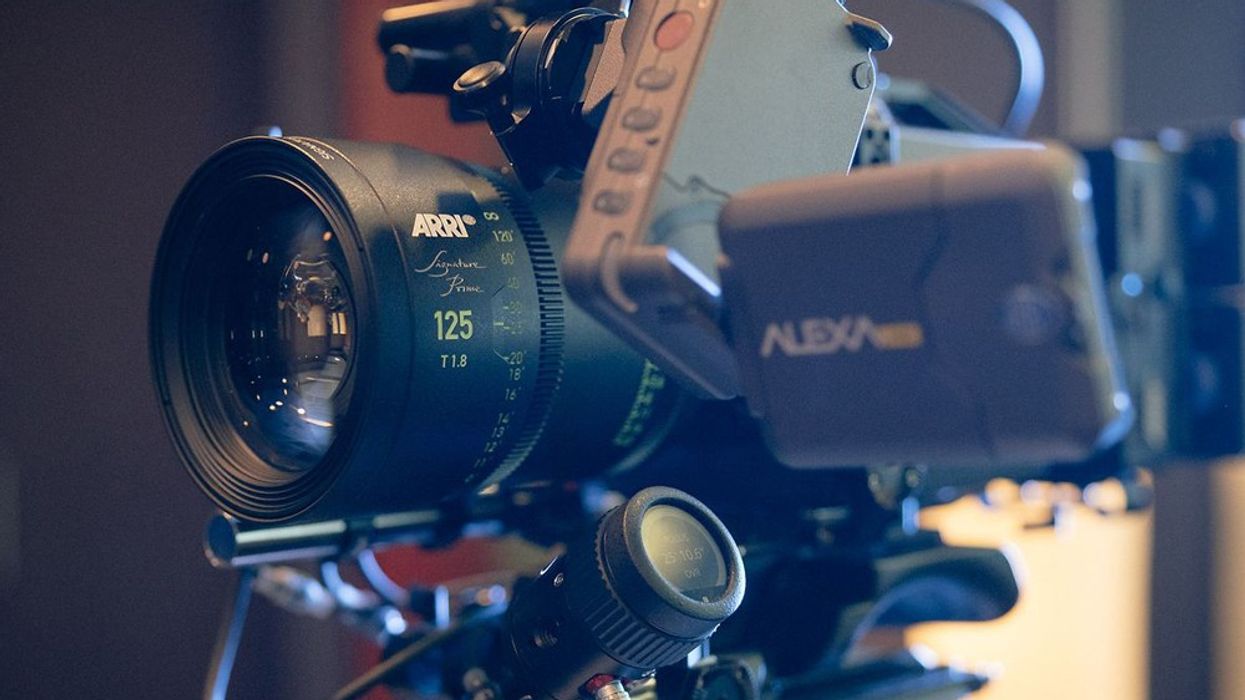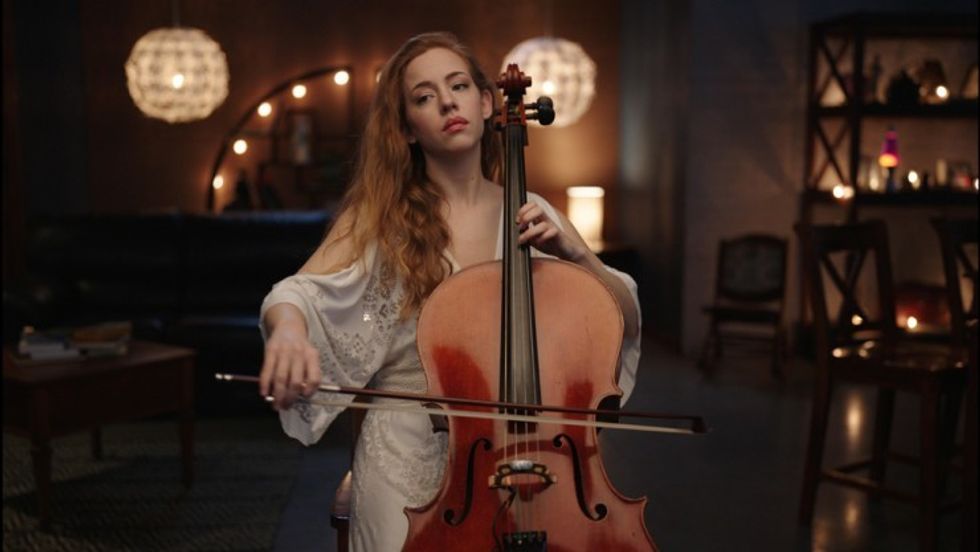How ARRI Signature Primes Separate Themselves From Other Lenses
First impressions of the large format glass.

In late 2018, ARRI introduced the ALEXA LF and Signature Primes as part of its “Large Format” camera system. What ARRI had done was take its renowned image quality and developed it to record a 4K image using a sensor slightly higher than full-frame (36.70mm x 25.54mm). The ALEXA Mini LF followed a year later.
While both cameras have received a ton of attention, the Signature Primes have slipped under the radar. With a 46mm image circle, the lenses are for large format but work equally well with Super 35. No Film School was able to get up close with them to learn more. Characteristically, the Signature Primes are different in many ways than other ARRI lenses and its competitors. Here’s what you need to know.
Showreel Watch
New Page
In years past, ARRI partnered with Zeiss or Fujinon to develop some of its lens options. For the Signature Primes, it’s a completely new partner. In fact, ARRI is working with a company that has never made a cinema lens before. This was purposely done so that ARRI could collaborate with a company that didn’t have any preconceived notions as to what a cinema lens should be. Thus, the Signature Primes are exactly how ARRI wanted them to look.
What makes the Signature Primes stand out to me is that they’re not modern lenses wrapped in a vintage look. Since high-resolution workflows have become the norm, cinematographers are trying to find ways to soften the image either by using older lenses or other means. The Signature Primes were developed with future-proofing in mind where emerging technologies like 4K DCI, 8K and HDR are key in the design. Now, this isn’t to say the lenses are overly sharp. They’re not. The lineup produces a natural-looking image with great roll and a soft texture that's inherently unique.
Focal Lengths
Signature Primes consists of 16 different focal lengths ranging from 12 to 280mm. Most are T1.8 with a few exceptions. The same is true for the overall length of the lenses and front diameter. The majority weigh around 4lbs (1.8kg). The lightest is the 35mm at 3.7lbs (1.7kg) and the heaviest is the 280mm at 9.48lbs (4.3kg).
Aperture
- T1.8-T22: 12, 15, 18, 21, 25, 29, 35, 40, 47, 58, 75, 95, 125, 150mm
- T2.5-T22: 200mm
- T2.8-T22: 280mm
Length from flange
- 239mm from flange: 12mm
- 197mm from flange: 15mm
- 178mm from flange: 18, 21, 25, 29, 35, 40, 47, 58, 75, 95, 125mm
- 208mm from flange: 150mm
- 218mm from flange: 200mm
- 278mm from flange: 280mm
Front diameter
- 134mm front diameter: 12, 280mm
- 156mm front diameter: 15mm
- 114mm front diameter: 18, 21, 25, 29, 35, 40, 47, 58, 75, 95, 125, 150, 200mm
Resolution
There will always be compromises when designing a lens. Resolution isn’t one of them on the Signature Primes. While resolution also depends on the camera sensor, ARRI somehow preserved all the resolution of the lens without the heavy micro-contrast we commonly see with high-resolution lenses.
There’s a strong separation between the focus and out-of-focus parts of the image where the in focus objects feel naturally sharp rather than artificially sharp. It’s very pleasing to the eye and consistent throughout the focal lengths.
Skin Tones
[youtube https://www.youtube.com/watch?v=twobOUE-oy4Skin tones is where the lenses shine. It's the first attribute I look at when considering a lens. We use the term “natural” quite often when describing how skin tones look but the Signature Primes create a new standard. To me, the lenses don’t get in the way of the image at all. They manage to capture all the resolution without adding contrast. It’s as if you’re looking at the person in front of you.]
In my opinion, lenses should not add color or contrast to an image. I prefer a neutral lens that allows me to decide what the image should look like later. The Signature Primes are not neutral and do add a hint of warmth to the skin tones but on the lower side. I also found the lenses to be consistent in color reproduction.
Bokeh/Lens Flare
The focus roll off is fast and smooth largely due to the spherical aberration correction in the lens. There are no hard edges in the bokeh giving an almost creamy look. The 11-blade iris design creates nicely rounded highlights. There’s also a slight vignette from wide open until about T2.8. All the vignetting is consistent in the entire focal range. The same is true for the look of the bokeh.
In terms of flare, ARRI did not eliminate it but it's much less distracting while still pleasing to the eye. The reasoning behind the move is to provide more range working in HDR.
Chromatic Aberration / Focus Breathing
Every lens will have chromatic aberration. The Signature Primes are no different. However, ARRI has minimized chromatic aberration by having it go from warm or cool as opposed to green or magenta. Thus, the chromatic distortion that does occur will appear as more natural colors in the image. There’s less than 1% distortion across all focal lengths.
Focus breathing is also common but the Signature Primes hold up very well. You’ll see slightest of lens breathing in the wider and longer focal lengths, but between 25 to 95mm, it’s virtually unnoticeable.
Rear Filter Holder
This is another feature I like about the lenses. The rear filter holder is exactly what it sounds like: a magnetic holder that’s placed on the rear of the lens where you can add any material to create a filter. You can insert fabric, different paper or material to affect the bokeh, flare and diffusion to create a customized look. It makes me think about all those old school tricks. Anyone have a pair of stockings?
You can also add an optical element into the rear holder. Glass or polycarbonate diopters both work. You would only need to get its size customized. Even the way the diopter faces will change the quality of the image. When you place the curve towards the lens it will have a stronger effect than facing the curve toward the sensor. There’s a lot to play with and consider from a small magnetic ring. This is a welcome option.
Mount
Signature Primes have an LPL (Large Positive Lock) mount. It’s a new universal standard created by ARRI that’s open to third parties. It’s based on the PL mount ARRI introduced back in the 1980s but has a wider diameter of 62mm and shorter flange focal distance of 44mm.
The new mount is a response to modern digital cameras. The focal distance on the PL had to be 52mm to leave room for film’s spinning mechanical shutter. Since there’s no spinning shutter in modern digital cameras, ARRI could move it closer and develop better performing lenses.
LPL covers all of ARRI cameras from the ALEXA 65 down to the AMIRA. To distinguish LPL, ARRI added blue locking levers so when you use the ARRI PL-to-LPL adapter, you can easily distinguish what you're releasing. If you want to shoot with the Signature Primes on other cameras, like RED, Sony VENICE, Sony E-mount or Fujifilm G-mount, you’ll need a third-party adapter.
Field Use
Roger Deakins showed us in 1917 how well the Signature Primes perform under complex situations, but we sought other reactions to paint a larger picture until we fully test them.
Cinematographer Shelly Johnson(Captain America: The First Avenger, Greyhound)
“The way I try to work is to learn the equipment, put it into my muscle memory and then forget about it so I can free my brain up to think about what’s happening on set with the story and our goals with the director and actors. The last thing I want to think about is the equipment.
I was drawn to these lenses because they have a lower contrast and there’s more detail in the blacks. When you first look at the Signature Primes you think it’s an imperfect lens, but when you start looking at them more, you see they’re perfectly engineered with a lot of fidelity. They have a roundness and smoothness to them that’s inspiring."
Cinematographer Carlos Verón(Full-Dress, Echo Boomers)
“I was looking for lenses that were sharp and would fall off quickly, especially in wide-angle focal lengths. I also wanted flares and a way to filter the lens. I loved how sharp the lenses were but also how quickly the roll off goes completely soft and beautiful.
The look I was going for in Echo Boomers referenced Japanese anime. The way this specific type of anime is drawn is it has a foreground plate, the character and then the background is soft. There’s no middle ground. I tried to build things that way where you have a foreground and the background goes soft. These lenses were almost made for that look.”
Cinematographer Fernando Argüelles(Hemlock Grove, Swamp Thing)
“When director Mike Rohl came up to me about photographing The Princess Switch 2 with Vanessa Hudgens, I asked him why he picked me. Everything I’ve done in my career has been dark and moody. He said I needed the challenge. And he was right. This movie was completely the opposite of what I’ve done. It called for a certain beauty. A certain glossy look. I thought a lot about the glamour look of the ‘40s and ‘50s and photographer George Harrell. He used the classic Rembrandt style and I wanted to emulate that for this project.
I ended up finding the Signature Primes and liked them because they’re not too harsh or have too much contrast. With the ALEXA LF, they created a beautiful look that had depth. The image also had shadows and separation but still kept an uplifting look we wanted. It’s one of the reasons why I picked the lenses. They blend a mix between vintage and modern that can be soft but doesn’t lose their sharpness.”
Price & Availability
For most of us, the Signature Primes will be rentals. Each lens costs over $20,000 and a set of six goes for roughly $150,000. Below is the current cost of each focal length. Bear in mind, these lenses are an investment that lasts multiple decades. There are ARRI lenses still in use made from the 1970s and ‘80s.
- $39,950: 12, 280mm
- $32,440: 15, 150mm
- $27,430: 18mm
- $26,180: 21, 125mm
- $24,920: 25, 29, 35, 40, 47, 58, 75, 95mm
Conclusion
From skin tones to its natural creamy look, the Signature Primes are very impressive. It’s also important to not think of them as large format versions of the ARRI Master Primes or ARRI Ultra Primes. They are completely unique. In fact, they’re not only a solid choice for large format but Super 35 as well. In some ways, the Signature Primes will work better because their soft bokeh will bring a little bit of the large format depth separation feel to Super 35 cinematography. Have you used the Signature Primes? Let us know what you think of them in the comments below.











![Ethos, Pathos, Logos: 20 Effective Ways to Advertise [Infographic]](https://nofilmschool.com/media-library/ethos-pathos-logos-20-effective-ways-to-advertise-infographic.jpg?id=34064614&width=600&height=600&quality=90&coordinates=560%2C0%2C0%2C0)

